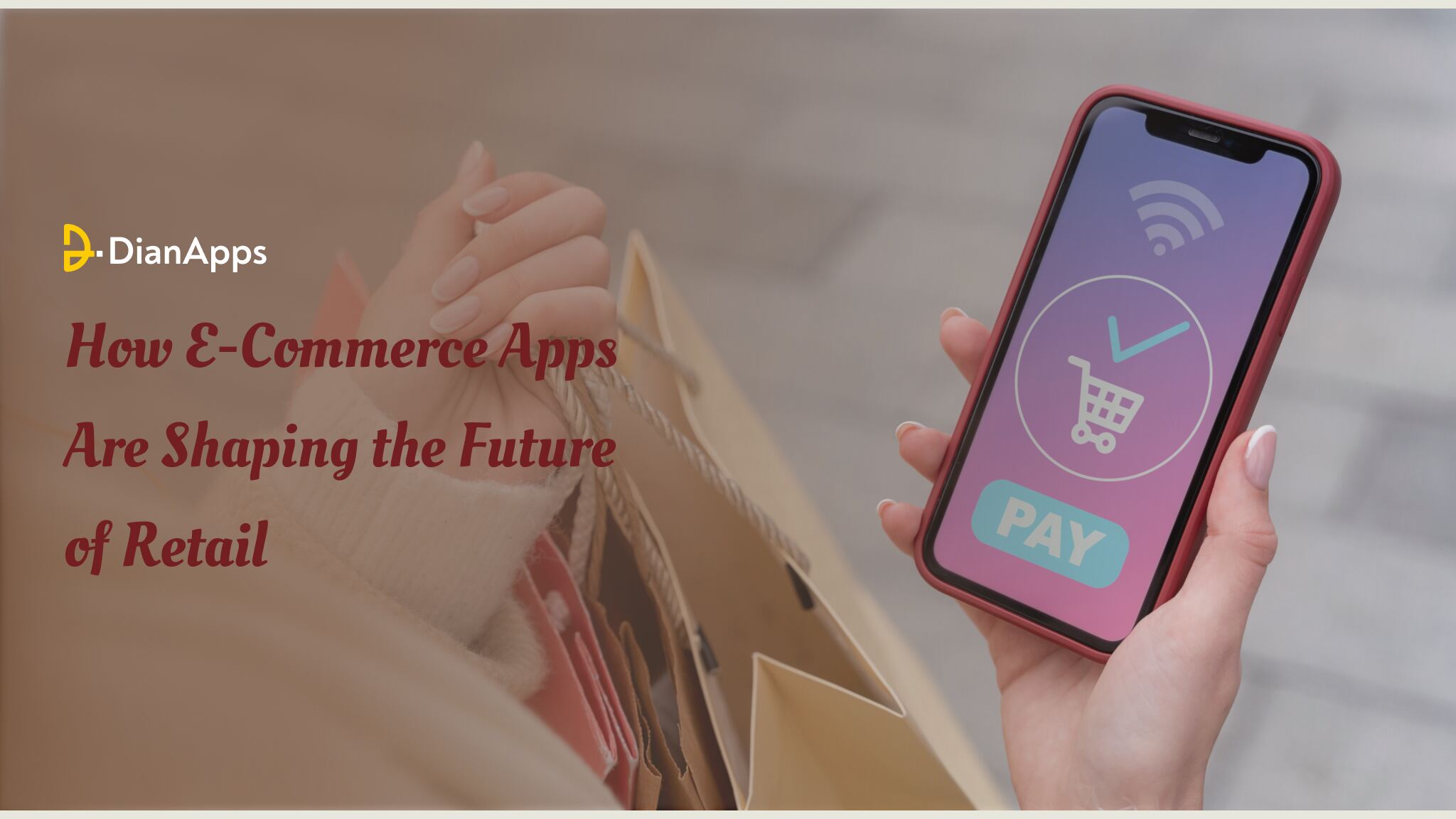How E-Commerce Apps Are Shaping the Future of Retail
With just a swipe, you can get new items, shop from your couch, and have it all delivered to your doorstep—sometimes in one day. Due to the rise of e-commerce applications, this is no longer a dream but a reality we now live in. Besides changing the way we shop, these apps have completely changed the retail landscape.
Simultaneously, retailers large and small can embrace customer-centric, mobile-first shopping experiences that meet both their wants and needs. E-commerce applications are changing the way we interact with and buy from companies, from personalized product recommendations to expedited cash sales and streamlined post-shipment processing.
E-commerce apps have been the driving force behind the massive transformation that the retail industry is undergoing. Knowing how these applications are impacting the retail space is important, whether you are a consumer taking advantage of the benefits of the digital marketing era or a company trying to stay on top of trends. If you are in the retail industry and want to grab all these benefits you can ensure to connect with an e-commerce app development company.
We look at how eCommerce applications are impacting everything from delivery improvements to customer experience as they pave the way for the future of retail in this blog post. Let’s get started!
Different Types of E-commerce Applications
E-commerce applications are designed to meet a wide range of demands from businesses and their customers. Having an understanding of the eCommerce apps is essential to understanding how they affect the retail sector.
B2C (Business to Consumer) Apps
B2C apps are probably the most popular and most users are familiar with it. These are retail apps that companies sell directly to consumers. Popular examples are Alibaba, Walmart, and Amazon. To make shopping as easy as possible, B2C applications provide a streamlined shopping experience that typically includes product recommendations, secure payment methods, and user feedback.
B2B (Business to Business) Apps
On the other hand, B2B e-commerce applications facilitate business-to-business transactions. These apps allow manufacturers and wholesalers to sell more products to other companies. The industry is served by companies such as Thomasnet and Alibaba, which provide businesses with a marketplace for a wide range of services.
Recommended Read: How Can Mobile Apps Help You Increase Sales of your eCommerce Business?
C2C (Consumer to Consumer) Apps
Direct purchases and sales between customers are made possible through C2C e-commerce applications. Popular sites like eBay and Poshmark offer a platform for people to sell products directly to other buyers, and these sites rely on peer reviews, user-generated content, and safe methods so pay more to build user confidence, from antiques to second-hand clothing.
C2B (Consumer to Business) Apps
C2B apps are a recent example in the e-commerce space. Customers can use these channels to provide goods or services to businesses. Platforms like 99designs, where people sell their creative work (such as illustration and photography) to companies in need of such services, are examples of this type of software.
Mobile Commerce (M-Commerce) Apps
M-commerce applications are specifically designed to facilitate transactions on mobile devices. In recent years, the rise of mobile internet usage has led to an explosion of this e-commerce software. Retailers are now optimizing their websites and apps to ensure a flawless shopping experience on smartphones and tablets.
Companies can serve different groups of customers by offering a variety of e-commerce applications, each with specific purchase behaviors. These different factors affect how individuals buy and drive the expansion of online shopping.
Role of E-commerce App Development in the Retail Industry
The development of e-commerce apps is important in how the retail sector will evolve in the future. E-commerce app developers are leading this digital revolution as companies strive to deliver engaging, convenient, personalized shopping experiences.
Enhancing Customer Experience
Creating apps that provide a seamless and enjoyable shopping experience is the main goal of e-commerce app development. Modern e-commerce applications incorporate features such as faster navigation, user-friendly interfaces, and personalized recommendations to appeal to customers. The goal of these applications, whether from electronics retailers like Best Buy or clothing brands like Zara, is to make shopping as easy and efficient as possible.
Seamless Payment Integrations
Providing a secure and easy way for customers to pay is essential for any retail outlet. Digital wallets such as Apple Pay and Google Pay, as well as credit cards, have been integrated into the development of the eCommerce app. Offering a variety of payment methods allows customers to shop as they please, making payments more convenient.
Real-Time Analytics and Data
E-commerce applications provide businesses with useful information about consumer behavior, helping them optimize their channel. App developers use advanced analytics technology that allows retailers to track parameters such as product preferences, frequency of orders, and shopping patterns. Companies can use this information to inform their pricing, marketing, and inventory decisions.
Cross-Platform Compatibility
With customers using a variety of devices including PCs, tablets, and smartphones, it’s important to have an app that works flawlessly across all platforms. By providing a consistent and seamless shopping experience on mobile, desktop, and other devices, developers ensure e-commerce applications are optimized for devices This flexibility helps merchants to expand their potential customers to reach a wider audience.
Key Trends of the Retail Industry
E-commerce applications are largely responsible for the rapid changes in the retail landscape. The following important trends are influencing how shopping centers will develop in the future.
Personalization and AI
E-commerce applications use artificial intelligence (AI) to cater to the personalized shopping experiences that consumers now demand. Artificial intelligence (AI) systems analyze customer data to make tailored recommendations, predict shopping patterns, and even base customer preferences based on existing purchases.
Omnichannel Retailing
Traditional outlets are not only found in physical locations. Whether using a PC to shop online or a smartphone app to check availability, today’s shoppers want a seamless experience across multiple channels and retailers are using omnichannel technology to enable shoppers to shop when and whenever they want to. They connect through a variety of channels including physical stores, social media, online marketplaces, and mobile apps.
Subscription-Based Services
Subscriptions are becoming increasingly popular in retail. Ordering services are increasingly being accessed through e-commerce applications, where users make regular payments to receive regular orders. The concept is beloved in areas such as food distribution, fashion and fashion. For example, apps like Stitch Fix offer custom fashion boxes based on customer preferences.
Augmented Reality (AR) Shopping
Consumers can now experience products almost before they buy thanks to augmented reality (AR), which is completely changing the way people shop. Through augmented reality (AR) technology, many e-commerce applications allow consumers to control how furniture will appear in their homes or how shoes will fit on their feet, without ever having to visit a store. Online shopping is more appealing and exciting because of this combined experience.
Sustainability and Ethical Practices
Consumers are increasingly aware of the social and environmental impact of their purchases. In response, retailers are pushing for more sustainable practices, offering environmentally friendly products, and ensuring their supply chains are transparent. Carbon footprint monitors and other sustainability features have been added to e-commerce applications to help users make ethical purchases.
How E-Commerce Apps are Innovating Delivery Systems
Innovation in the shipping and logistics industry is one of the major reasons for the growth of e-commerce apps. A pleasant customer experience depends on fast and efficient delivery, and e-commerce applications are at the forefront of this shift.
Same-day and Express Delivery
Never before has there been such a need for fast and easy delivery. Technology that allows same-day and faster delivery is used by e-commerce applications. With apps like Amazon Prime, items can be delivered the same or next day, allowing customers to receive their purchases on time. Delivery methods in the future may become much faster with the introduction of drones and driverless cars.
Real-Time Tracking
E-commerce applications provide real-time order tracking, and customer demand. Customers can keep an eye on their items from the moment they leave the warehouse until they arrive at their door thanks to incredible tracking capabilities. This transparency increases the confidence of buyers and sellers.
Last-Mile Delivery Solutions
Last mile delivery, sometimes referred to as final stage delivery, is often the most difficult and expensive part of transportation. E-commerce platforms are addressing this problem by introducing new options including offering freight forwarders, partnering with nearby delivery companies, and even crowdsourcing options on the use of local commodities.
Sustainable Delivery Practices
E-commerce apps are figuring out ways to reduce the negative environmental effects of delivery as more and more customers place a higher value on sustainability. Some apps are utilizing electric vehicles for transport, integrating green delivery choices, or providing environmentally friendly shipping options for clients who care about the environment.
Recommended Read: Rise of M-Commerce: Trends to Watch Out In 2025
Final Words
There is no doubt that eCommerce apps are increasingly influencing how retail will evolve in the future. These apps are at the forefront of the retail revolution, from offering conversion programs to delivering personalized shopping experiences. As technology continues to evolve, we can expect more innovation in e-commerce app development, making shopping more consistent, convenient, and enjoyable for consumers and businesses.
Embracing these changes is essential for stores to compete in what is now a highly digital world. Companies can position themselves for success in the retail market of the future by embracing the latest trends and harnessing the power of e-commerce apps. To leverage all these functions you must connect with a mobile app development company.
A well-designed, feature-rich eCommerce application is essential if your company wants to stay ahead of the curve to ensure long-term success in attracting today’s tech-savvy customers.




